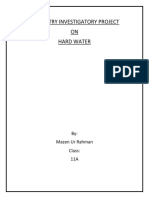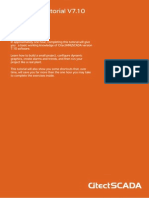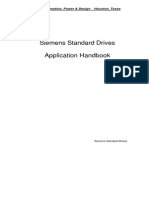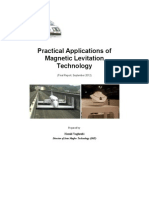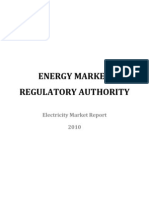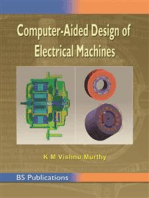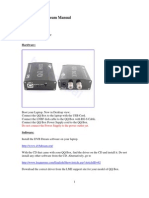Permanent Magnet Generator
Permanent Magnet Generator
Uploaded by
Ciutacu LeonardCopyright:
Available Formats
Permanent Magnet Generator
Permanent Magnet Generator
Uploaded by
Ciutacu LeonardOriginal Description:
Copyright
Available Formats
Share this document
Did you find this document useful?
Is this content inappropriate?
Copyright:
Available Formats
Permanent Magnet Generator
Permanent Magnet Generator
Uploaded by
Ciutacu LeonardCopyright:
Available Formats
Progress In Electromagnetics Research, Vol.
129, 345363, 2012
COMPARATIVE EVALUATION ON POWER-SPEED DENSITY OF PORTABLE PERMANENT MAGNET GENERATORS FOR AGRICULTURAL APPLICATION M. Norhisam1, * , S. Ridzuan1 , R. N. Firdaus1 , C. V. Aravind1 , H. Wakiwaka2 , and M. Nirei3
1 Department 2 Faculty
of Electrical and Electronics, Faculty of Engineering, Universiti Putra Malaysia, Serdang 43400, UPM, Malaysia of Engineering, Shinshu University, 4-17-1 Wakasato, Nagano 380-8553, Japan
3 Nagano
National College of Technology, 716 Tokuma, Nagano 3818550, Japan AbstractThe comparative evaluation based on the power speed density of several types of portable Permanent Magnet Generator (PMG) considered for agricultural applications is presented. These generators are purposely designed to be used in agriculture sectors and thereby it should be of lightweight, small in size and ease to use. Six dierent generator topologies are developed for investigation of such purposes. A number of design parameters are considered to analyze the performance characteristics for each type of developed PMG. Based on the power speed density factor that is used to describe better generator performance, the suitable PMG for the agricultural application is identied through a comprehensive evaluation. 1. INTRODUCTION Recently, the demand for standalone power sources is increasing, in particular such as in agriculture, tourism, construction, landscape decoration, sports and military service. The standalone application requires an electrical supply that depends on the requirement of batteries with its limited power capability and reduced life cycle as with heavy loads. Portable electro-mechanical equipment such as electrical cutter, electrical chopper, electrical grinder and electrical harvester for
Received 1 May 2012, Accepted 12 June 2012, Scheduled 26 June 2012 * Corresponding author: Misron Norhisam (norhisam@eng.upm.edu.my).
346
Norhisam et al.
agriculture are few to name. The generator developed and investigated is used for powering mechanical cutter in palm fruit harvesting that require to be portable. Therefore, a portable power supply with a small size and light-weight of Permanent Magnet Generator (PMG) is highly required. A small size portable diesel engine is used as a prime mover in this investigation. Various works have been carried out to analyze and model the characterization and performance of several types of PMG. Most of them usually focus on the design and optimization such as of the PMG for wind turbine application [14]. Some of them are determined for loss evaluation and design optimization for direct driven PMG using simulation [5]. Reference [6], presents the optimal design of stator interior PMG with minimized cogging torque for wind power application. In reference [7], a new type of permanent magnet micro-generators is introduced that is suitable for very low power applications such as hand phone, hand watch, and PDA. Most of the papers above only focus on modeling and optimization of its own structure of PMG. Some of them focus on micro-generators where the overall size of PMG determines whether it is intended for high or low power application. The development of PMG that intended to be used in agriculture application where it demand high power capability, small in size and ease of use is much limited in practical applications. In context to that, several topologies of PMG are designed and developed recently [818]. However, a perfect evaluation on the best possible of PMG for the desired application is to be investigated further. This paper describes the comparative studies on the power speed density of several types of portable permanent magnet generator for agriculture application that are developed. The nominal rotor speed for PMG is 3000 rpm based on the prime mover. Numerous design parameters are considered for analysis on the performance characteristics to derive the best model that was fabricated earlier [814]. The power speed density factor that is used to describe the generator performance suitable for the agricultural application is used as the evaluation parameter. A comprehensive analysis is performed and based on the power speed density factor the choice of PMG for the application of interests is proposed. Although the generators developed are for agricultural applications but this can also be used for small size portable commercial and industrial applications. 2. PORTABLE PERMANENT MAGNET GENERATORS 2.1. Constructional Features of Various PMG Most commonly used commercial permanent magnet generators are of single stator and double stator structure depending upon the torque
Progress In Electromagnetics Research, Vol. 129, 2012
347
and power density requirements. Further there are also slot type and slot-less type depending upon the shape of the permanent magnet structure used. Slot type refers to the stator that is made from ferromagnetic material that keeps the winding in place whereas, slotless type refers to the stator that is made from non-ferromagnetic material that keeps the winding in place [13]. Higher ux density in the air gap is achieved in slot type as the mechanical gap between the rotor and stator slot is small resulting in a higher magnitude of output voltage, but with the increased ripple in the output waveform. Meanwhile, slot-less type ensures a good sinusoidal waveform of output voltage smaller in magnitude with reduced ripple. The generator under investigations is designed as a portable unit that supplies stand alone electrical power used for agricultural application. The generator is designed for single phase operation thus the coil is connected in series to produce the variable AC voltage. The operating principle is based on the electromagnetic induction between the stator and the rotor, with the rotor enclosing the magnet. As the rotor rotates the revolving magnetic ux emulating from the magnet ows towards the slot at the stator. A voltage is induced by the winding coil at the slot due to the rate of ux changes that travels along the other stator core, return to the air gap and completes the ux path through the magnet placed at the other side. For all the generators under considerations the rotor and stator are made from magnetic material such as soft steel (SS400) and the shaft is made from non-ferromagnetic material (SUS403). The rare earth permanent magnets (NdFeB) are used as a permanent magnet. The dierent types of generators considered for the investigations are presented as below. Table 1 shows the structure of various types of developed PMG in this research. Table 2 shows simulation on the ux distribution of various types of PMG. Dierent variations on the use and shape of the magnet structure is investigated by other researchers [1619]. 2.1.1. Single Stator Slot Type Permanent Magnet Generator Single Stator Slot Type Rectangular (SSRPM) permanent magnet generator consists of stator coil and stator teeth [11, 12] is shown in the Table 1. The rotor structure is embedded with the rectangular permanent magnets, the rotor core, and a shaft. This gives an advantage for the rotor to operate at high-speed application with spacing of the permanent magnets at the appropriate spacing. Also, the use of only one PM provides the required ux to interact with each pole on the stator side. The ux lines of permanent magnet in SSRPM ow directly to the stator pole as can be inferred from Table 2. There exists a smaller percentage of ux leakage between permanent
348
Norhisam et al.
magnet poles. The ux density in stator pole is as close to 2.0 T, but well below the saturation limit of 2.2 T. This means that the optimal consideration of stator pole Volume and coil space is achieved with this dimension. Table 1. Structure of various type of developed PMG in this research.
stator Slot Slot-less
Single
Rectangular PM (SSRPM)
Symmetrically PM (SSLSPM)
Arc PM (DSAPM) Double
Single Pole PM (SPPM)
Rectangular PM (DSRPM)
Multiple Pole PM (MPPM)
Progress In Electromagnetics Research, Vol. 129, 2012
349
Table 2. Flux distribution of various type of developed PMG.
Stator Slot Rectangular PM (SSRPM) Slot-less Symmetrically PM (SSLSPM)
Single
Flux lines
Flux density
Flux lines
Flux density
Arc PM (DSAPM)
Single Pole PM (SPPM)
Flux lines
Flux density
Flux lines
Flux density
Double
Rectangular PM (DSRPM)
Multiple Pole PM (MPPM)
Flux lines
Flux density
Flux lines
Flux density
2.1.2. Single Stator Slot-less Permanent Magnet Generator The basic structure of Single Stator Slot-less Symmetrical (SSLSPM) permanent magnet generator comprises coils on the stator without the
350
Norhisam et al.
slot teeth as shown in Table 1 [7, 10, 13]. The coil is wound according to its shape and glued to the yoke. The rotor structure comprises permanent magnets, rotor core, and a shaft. The permanent magnets are of rectangular shape and are placed diametrically in V-shape pattern. This V-shape pattern gives advantage for PMG by providing additional ux density in the air gap even though the mechanical gap is bigger as can be inferred from Table 2. In this topology, the same pole polarity of permanent magnet is kept facing each other. 2.1.3. Double Stator Slot Type Permanent Magnet Generator Double Stator Slot type Arc Permanent Magnet (DSSAPM) as shown in Table 1, has two stators at the outer surface and a single rotor in the inner sides [9]. The arc type permanent magnets are embedded inside the rotor and are magnetized in the circumferential direction. The magnets are placed between the wedges of magnetic material of the pole pieces in the rotor. The stator and rotor are made from magnetic material and non-ferromagnetic material, respectively. The uxes traverses along the stator core, return across the air gap and then enter the pole of the other permanent magnet. The advantage of the double stator topology is that it increases the output power of the PMG. The implementation of the double stator topology eliminates the ux linkage that increases the output of the PMG as shown in Table 2. The use of inner stator is to optimize the usage of the ux leakage problem that occurs in a single stator generator due to the radial ux direction. Normally, single stator topology produces ux leakage that occurs around the PM. Usually, the magnetic ux passes the air gap, encircles the stator windings and passes the air gap again and back to the rotor, thereby providing the magnet a ux linkage. Even though double stator topology is highly intricate to fabricate, they are nding more suitable applications due its better eciency. Another double stator type called DSRPM that uses a rectangular type of magnets in the rotor. Similar to DSAPM, the magnet of DSRPM is magnetized in the circumferential direction and is magnets are surface-buried in the rotor. The advantage of using rectangular type of magnet is that it reduces of the size of the magnet and the reduction of the complexity on the rotor fabrication. 2.1.4. Double Stator Slot-less Type Permanent Magnet Generator Table 1 also shows constructed Double Stator Slot-less Single Pole PM (SSPM) [10] and the Double Stator Slot-less Type Multiple Pole Permanent Magnet (MPPM) [9]. In the SSPM type, the outer and inner stator is composed of only coils without the slot teeth. Each coil
Progress In Electromagnetics Research, Vol. 129, 2012
351
is wound according to its shape and glued on to their respective outer and inner stator. The advantage of using an arc permanent magnet is to achieve higher magnetic ux density by utilizing the maximum rotor size as shown in Table 2. However, in comparison with double stator slot type topology this SPPM use the slot-less stator topology that has large air gap, thus the existence of the leakage ux though unavoidable, but can only be minimized. With reference to the SPPM with the arc shape double stator, a Multiple Pole Type Permanent Magnet (MPPM) with rectangular shape is used for the same structure. The advantage of this structure is to reduce the weight and at the same time maintain the output power of PMG. Furthermore, by using rectangular shape PM, the fabrication is easier than arc shape PM. The other part of the generator is similar in structure with SPPM. 2.2. Power Generation Concepts in PMG The internally generated voltage in the generator is based on Faradays Law as in (1). Hence, the rotation of the rotor produces rotating magnetic eld in the stator. Consequently, the voltage is induced by the winding coil at the air gap due to its rate of change of ux. The generated RMS voltage, EG by the generator for one pole is calculated as in (2). Vemf = N EG d dt = 4.44f N [V] [V] (1) (2)
where Vemf is the induced voltage in [V], N the number of turns, the ux through each turns in [Wb], EG the RMS voltage in [V], and f the rotation frequency of the PMG in [Hz]. The generated voltage for a single stator is from the only coil winding at the air gap. However, for a double stator, the coil winding at the outer and inner air gap induces the voltage in the PMG. The maximum current, Ia of the generator when connected to a pure resistance load RL is derived as in (3). Ia = EG (Ra + RL )2 + (2f Lc )2 [A] (3)
where Ra is the armature resistance of the coil winding in [], RL the load resistance in [], and Lc the inductance of the coil winding in [H]. According to this equation, it shows that the current owing depends on the internal generated voltage and coil inductance. Figure 1 shows the basic electrical equivalent circuit of the generator that is connected to a pure load resistance RL . The
352
Norhisam et al.
Ra
jXs
Ia
Vemf
Load
RL
Ea
Figure 1. General electrical equivalent circuit. calculation to determine the performance of the generator is based on this circuit. Here, the value of RL is xed for 95 . This circuit is used as a reference in order to determine the performance of the generator by varying the Ra and Xs value. Here, Ia is the armature current in [A], and Xs is the synchronous reactance of the generator that composed of inductance of coil winding Lc and the armature eect in []. The machine losses considered includes the losses due to the armature reaction eect, the copper losses, and the iron losses. The general equation to calculate the armature reaction is given in Equation (4). The copper losses and iron losses that include the hysteresis and eddy current is calculated based on Equation (5). dIa Ea = Lc [V] (4) dt 2 Pl = Ia Rc + h f B + e f 2 B 2 [W] (5) where Ea is the armature voltage in [V], Pl the total losses power in [W], Rc the coil resistance in [], h the hysteresis coecient (2.46 102 ), e the eddy current coecient (8.55 103 ), a constant (2.03), and B the ux density of the magnet in [T]. The total output power, Po that is generated by the generator is calculated based on Equation (6). For a single stator, the calculation is simple because it just has one voltage source. Po = (EG Ea ) Ia Pl [W] (6) However, for a double stator the calculation is separated between inner and outer voltage source as shown in Equation (7). This means that the calculation for a double stator is for the inner coil winding and outer coil winding. Subsequently, both output power is combined to obtain the total output power generated by the PMG in double stator strategy. Po = [(EGo Eao ) Iao Plo ] + [(EGi Eai ) Iai Pli ] [W] (7)
Progress In Electromagnetics Research, Vol. 129, 2012
353
Figure 2. Experimental measurement setup used in this investigation. The input mechanical power that rotates the PMG is calculated using the value of torque as Equation (8). 2 T n [W] (8) 60 where Pm is the mechanical power of the machine in (W) that acts as a prime mover, T the torque value in (Nm), and n the rotational speed in (rpm). The value of torque is found through the measurement set-up as shown in Figure 2. The generator (denoted as PMG) is connected to a pure resistive load of 95 . The voltage signal is measured between its terminals while the current is measured using a standard resistance of 1 . The torque sensor is located between the PMG and DC motor that act as its prime mover. Finally, the eciency, is calculated as, Pm = P0 100 [%] (9) Pm The torque is measured using the torque sensor and the mechanical power is calculated using Equation (8). The output power is calculated from Equation (6) or (7) depending upon the type as single and double slot topology respectively and the eciency is calculated by Equation (9). = 2.3. Characteristics of Various PMG Based on the concept presented in the previous section, a lot of design parameter is studied using Finite Element Method (FEM) and
354
Norhisam et al.
Permeance Analysis Method (PAM) [915]. The numerical method used for the analysis of the rectangular permanent magnet slot type of generator is presented in brief. The same method of permeance analysis is used for the analysis of other types of generators used in this invesitgations. Basically, the ux, induced by the permanent magnet is calculated by using PAM. The direction of ux ow is considered based on the software analysis by using Finite Element Method (FEM). The permeance consideration area and its magnetic equivalent circuit are shown in Figure 3. As can be seen in Figure 3(b), there are two permeance areas at the air gap were considered including at the permanent magnet. The permanent magnet is considered as air gap in order to determine the total permeance for the coil. However, to examine the ux produced by the permanent magnet, the permeance at the permanent magnet, Pm is short circuit. P1 is the permeance area between stator teeth and rotor and can be calculated using Equation (10). The magnetic permeance is given by Equation (11). P1 = Pm = o l ln 1 + wm l 2hm
g rr
[H] [H]
(10) (11)
(a)
(b)
P1
P1
Pm
Pm
(c)
Figure 3. Numerical computation for the rectangular slot type generator. (a) 2D ux direction (FEM). (b) Simplied ux path and permeance area in rectangular model. (c) Magnetic equivalent circuit.
Progress In Electromagnetics Research, Vol. 129, 2012
355
Here, o is the permeability factor in the air in [H/m], the permeability of the material in [H/m], the angle of stator teeth in [rad], l the deep length of the PMG in [m], g the air gap between stator teeth and rotor in [m], rr the rotor radius in [m], wm the width of the permanent magnet slot in [m], and hm the height of the PM slot in [m]. Based on the magnetic equivalent circuit in Figure 4, the total permeance, Pt for one pole is calculated by using Equation (12) and calculated cumulatively as the other poles are identical. (o wm l) 1 Ptl = [H] (12) 2 (2 h ) + (w ) ln 1 + g
o m m rr
As mentioned before, the permeance at the magnet is short circuited in order to determine the ux at the magnet. Therefore, the total permeance in order to nd the ux of the magnet is given by Ptf = o l 2 ln 1 +
g rr
[H]
(13)
Assume the B-H curve of permanent magnet and permeance line of the PMG shown in Figure 4. The intersection point of these two lines is an operating point of the permanent magnet for the particular permeance model. By solving the intersection of these two straight lines, the permanent magnet operating point can be determined as in Equations (14) until (16).
Demagnetization line of Permanent magnet
B(T)
Br Permeance line k Bk
H(kA/m) Hc Hk
Figure 4. B-H curve and operating point of permanent magnet.
356
Norhisam et al.
tan =
Ptf Hc hm Br wm l Bk = ( tan ) Hk Br Hk = Br Hc + tan
(14) [T] [A/m] (15) (16)
Here, the operating point of permanent magHc is a coercive force in (kA/m), Br a remnant ux density in [T], Bk a magnetic ux density of the permanent magnet at operating point in [T], and Hk the magnetic eld intensity of the permanent magnet at operating point in [A/m]. Consequently, the ux in the PMG can be calculated as: =
2 o Br Hc hm 2 2Br wm ln 1 + g rr 2 + (Hc o hm )
[Wb]
(17)
The inductance Lc and resistance Rc of the coil winding are calculated by using Equations (18) and (19), respectively. These values are necessary in order to identify the characteristic of the PMG especially the maximum current in the circuit. Furthermore, the capability of the generator is limited by the impedance of the stator coil. N2 (o wm l) [H] (18) Lc = 2 (2 h ) + (w ) ln 1 + g
o m m rr
Rc = N =
N 2 l A
2N 2 (l
+ wy + wc ) wc hc
[]
(19) (20)
wc hc dc dc
[]
Here, N is the number of turns, lc the length of coil winding in [m], A the area of winding slot in [m2 ], the density of copper [8900 kg/m3 ], wy the width of the stator yoke in [m], dc the diameter of the coil, wc the width of the coil slot in [m], and hc the height of the coil slot in [m]. From the initial study, analysis are carried to understand the performance and characteristics of each the generator structure. For each type of the generator, the best model based on the eld analysis is chosen for fabrication and are tested experimentally. For all of the generators used here, the outer diameter of stator core and the diameter of the shaft is selected to be kept at 104 mm and 10 mm respectively. The thickness of stator core is xed at 20 mm. Four dierent characteristics are evolved from the investigations
Progress In Electromagnetics Research, Vol. 129, 2012
357
namely, the torque-speed characteristic, the mechanical power-speed characteristic, the output power-speed characteristic and the eciencyspeed characteristic. 2.3.1. Torque-speed Characteristics Figure 5(a) shows the torque-speed characteristic to drive the generator. It is inferred that the torque increases linearly and is proportional to the speed of the rotor. DSAPM requires the highest torque characteristic to move the rotor since it has the highest slope compared to the DSRPM, SSPM, MPPM and SSRPM. The low torque characteristic is shown by SSLSPM. It is inferred that the PMG with slot-less topology requires lower torque compared to the slot type. Meanwhile the double stator topology develops higher torque compared to the single stator. This is due to smaller air gap in the slot type that contributes to the higher cogging characteristic compared to slot-less type.
Speed, n [rpm]
Mechanical Power, PM [W]
Torque, T [Nm]
Speed, n [rpm]
(a)
Output Power, P [W] O
(b)
Efficiency, [%]
Speed, n [rpm]
Speed, n [rpm]
(c)
(d)
Figure 5. Characteristics of the various PMG that are fabricated. (a) Torque. (b) Mechanical power. (c) Output power. (d) Eciency.
358
Norhisam et al.
2.3.2. Mechanical Speed-power Characteristics Figure 5(b) shows the mechanical power-speed characteristic of the prime mover of PMGs. Similar to the torque characteristic, it is seen that the mechanical power increases as the speed of rotor increases. For instance, at 2000 rpm the output power for DSAPM is 280 W whereas the torque that required to move the rotor at that particular speed is about 1.25 Nm. Meanwhile, the mechanical power that required to produce the same amount of torque by the prime mover at the same speed is 250 W and the eciency at that particular speed is about 84%. Again, DSAPM has the highest mechanical power characteristic to move the rotor since it has the highest torque compared to DSRPM, SSPM, MPPM and SSRPM. The lowest output power characteristic is shown by SSLSPM. 2.3.3. Output Power-speed Characteristics Figure 5(c) shows the output power vs speed characteristic for each PMG. This output power is determined using the calculation as presented in the previous section. For verication of the calculation, output power for each prototype is measured. However, only few of measurement results are shown in the graph. The calculated results are in good agreement with the measurement result. It is inferred that the output power increases almost proportional to the speed of the rotor. However, DSAPM has the highest output power characteristic since it has the highest slope compared to DSRPM, SSPM, MPPM and SSRPM. The lowest output power characteristic is shown by SSLSPM. DSAPM has the highest output power compared to DSRPM due to the bigger size of PM. Besides, a maximized and constant magnetic ux density along the surface of the arc is achieved due to the constant air gap between stator and rotor compared to DSRPM. Furthermore, it is inferred that the PMG with slot-less topology produce lower output power compared to the slot type. All these values of torque, mechanical power and the output power, the eciency of all the PMG are then calculated. 2.3.4. Eciency Characteristics Figure 5(d) illustrates the eciency of all PMG that are fabricated. It is inferred that the eciency of SSLSPM increases as the speed is increased until it reached the saturation point at speed 2000 rpm. For the other PMG, there are only small signicant changes of the eciency as the speed is increased. For example, among all PMG the DSAPM
Progress In Electromagnetics Research, Vol. 129, 2012
359
develops highest eciency of 93% at 1500 rpm. Therefore, it shows that DSAPM is superior to other PMG under investigations. 3. COMPARISON OF VARIOUS PMG In order to evaluate the best suitability of the generator, the ratio of power density of the Volume of the generator is selected as the evaluating parameter. This main reason is that dierent kind of PMG generate dierent values of torque, mechanical power, output power and eciency. Thus, by referring to power density, it shows the best possible PMG that produces the higher output power with the smallest of weight. The power-speed constant, Poc is calculated by nding the slope of output power when running at dierent speeds of PMG as shown in Figure 6. The Poc is calculated by Equation (21). y2 y1 Poc = [W/rpm] (21) x2 x1 The power speed density is then calculated using Equation (22) where the Poc is divided by Volume of the PMG. Pd = Poc /v [W/rpm/m3 ] (22) where v: the overall Volume of the PMG [m3 ]. Table 3 shows the comparison of various PMG prototypes that are fabricated based on the desired application. All the values here shown in the Table 3 are based on the measurement at 3000 rpm of the rotor speed. It is inferred that the highest output power is achieved by DSAPM (530 W) where as the lowest output power by SSRPM (194.88 W). The output power for SSLSPM, DSRPM, SPPM and MPPM are 62.26 W, 460 W, 261.8 W and 270.3 W, respectively.
Output Power, PO [W]
Speed, n [rpm]
Figure 6. Method in determine the power-speed constant.
360
Norhisam et al.
Table 3. Comparitive evaluation of the various PMG prototypes that are fabricated (at 3000 rpm).
Single Slot Item Output Power, Po [W] SSRPM 194.88 75.04 1 .554 1.92 x 10-7 0.089 463.54 x 10 15.54
3
Double
Slot-Less SSLSPM 62.26 4.24 1.452 1.80 x 10-7 0.047 DSRPM 460 10.2 1.703 2.16 x 10-7 0.201
3
Slot DSAPM 530 10.2 1.714 2.16 x 10-7 0.225
3
Slot-Less SPPM 261.8 2.32 1.523 2.08 x 10-7 0.174
3
MPPM 270.3 2.706 1.365 2.08 x 10-7 0.179
3
Inductance, L [mH] Weight, m [kg] Volume, v [m3]
Power Speed Constant, Poc [W/rpm] Power Speed Density , Pd [W/rpm/ m3] Resistance, R []
261.11 x 10 6.94
930.55 x 10 9.55
1041.67 x 10 9.55
836.54 x 10 4.05
860.58 x 103 4.05
This shows that for the same overall size and speed of generator, DSAPM is superior to other types generator presented. The value of inductance and resistance is higher for single stator especially slot-less type. This is because it encloses coil with bigger width in the stator rather that of the slot type. The highest inductance and resistance for the SSRPM type is 75.84 mH and 15.54 [], respectively. The low inductance and resistance is for the SPPM, about 2.32 mH and 4.05 [], respectively. It is inferred that low values of inductance and resistance contributes bigger output power of the generator. Furthermore, it is seen that the weight of generator is between 1.3 kg to 1.5 kg depending upon its type. The highest weight among the generator investigated is about 1.714 kg for the DSAPM and the smallest weight of 1.365 kg is for the MPPM topology as they use smaller permanent magnets and lower rotor weight. The highest power-speed constant of 0.225 W/rpm is achieved by DSAPM, as it exhibit higher slope of output power followed by DSRPM, MPPM, SPPM, SSRPM, and SSLSPM which are about 0.201 W/rpm, 0.179 W/rpm, 0.174 W/rpm, 0.089 W/rpm and 0.047 W/rpm, respectively. The power density of all the PMG is derived using the ratio of Poc to the overall volume. Based on Table 3, it shows that the highest power density of 1041.67 103 W/rpm/m3 achieved by DSAPM compared to other DSRPM (930.55 103 W/rpm/m3 ), MPPM (860.58 103 W/rpm/m3 ), SPPM (836.54 103 W/rpm/m3 ), SSRPM (463.54 103 W/rpm/m3 ) and SSLSPM (261.11 103 W/rpm/m3 ). Based on the above analysis, PMG with DSAPM topology is proposed as the high power density portable PMG for agricultural application. They can however be extended for similar applications in commercial and industrial sectors.
Progress In Electromagnetics Research, Vol. 129, 2012
361
4. CONCLUSION The comparative evaluation of the various types of generator that are developed for a portable electrical generator for agricultural application is presented. The characteristic including the torque, the mechanical power, the output power and the eciency is presented. In order to dierentiate the performance and capability of the generator, the power density, the ratio of power speed constant to overall Volume of the PMG is used as a performance evaluation factor. It is concluded based on the investigations that the DSAPM with its highest power density is the best generator for the desired application of interest as it develops high output power for a smaller size. REFERENCES 1. Jian, L., G. Xu, Y. Gong, J. Song, J. Liang, and M. Chang, Electromagnetic design and analysis of a novel magnetic-gearintegrated wind power generator using time-stepping nite element method, Progress In Electromagnetics Research, Vol. 113, 351367, 2011. 2. Lecointe, J.-P., B. Cassoret, and J.-F. Brudny Distinction of toothing and saturation eects on magnetic noise of induction motors, Progress In Electromagnetics Research, Vol. 112, 125 137, 2011. 3. Hosseini, S. M., M. A. Mirsalim, and M. Mirzaei, Design, prototyping and analysis of low cost axial ux coreless permanent magnet generator, IEEE Transactions on Magnetics, Vol. 44, No. 1, 7580, 2008. 4. Touati, S., R. Ibtiouen, O. Touhami, and A. Djerdir, Experimental investigation and optimization of permanent magnet motor based on coupling boundary element method with permeances network, Progress In Electromagnetics Research, Vol. 111, 7190, 2011. 5. Mahmoudi, N. A. Rahim, and H. W. Ping Axial-ux permanent-magnet motor design for electric vehicle direct drive using sizing equation and nite element analysis, Progress In Electromagnetics Research, Vol. 122, 467496, 2012. 6. Herrault, F., D. P. Arnold, I. Zana, P. Galle, and M. G. Allen, High temperature operation of multi-watt, axial-ux, permanentmagnet micro-generators, Sensors and Actuators A, Vol. 148, 299305, 2008.
362
Norhisam et al.
7. Arnold, D. P., Review of micro-scale magnetic power generation, IEEE Transaction of Magnetics, Vol. 43, No. 12, 39403951, 2007. 8. Norhisam, M., M. Nirei, M. Noraza, I. Aris, J. Abdul Razak, and H. Wakiwaka, Comparison of single and multiple pole permanent magnets in a double stator slot-less permanent magnet generator, Journal of the Magnetics Society of Japan, Vol. 34, No. 3, 407410, 2010. 9. Norhisam, M., M. Nirei, M. Noraza, C. Y. Sia, and H. Wakiwaka, Basic characteristics of double stator slot-type permanent magnet generator, Journal of the Magnetics Society of Japan, Vol. 34, No. 3, 385388, 2010. 10. Norhisam, M., R. Suhairi, M. Noraza, M. A. M. Radzi, I. Aris, M. Nirei, and H. Wakiwaka, Comparison on performance of a single phase and three phase double stator type permanent magnet generator, Proceedings of the 6th Asia Pacic Symposium on Applied Electromagnetics and Mechanics, 231234, Jul. 2010. 11. Norhisam, M., R. Suhairi, M. Noraza, M. A. M. Radzi, I. Aris, M. Nirei, and H. Wakiwaka, Comparison on performance of a single phase and three phase double stator type permanent magnet generator, Proceedings of the 6th Asia Pacic Symposium on Applied Electromagnetics and Mechanics, 231234, Jul. 2010. 12. Norhisam, M., M. Noraza, M. Shaq, I. Aris, J. Abdul Razak, H. Wakiwaka, and M. Nirei, Comparison on performance of two types permanent magnet generator, Journal of the Japan Society of Electromagnetic and Mechanics, Vol. 17, 7376, Supplement, 2009. 13. Norhisam, M., M. Noraza, M. Shaq, I. Aris, M. Nirei, H. Wakiwaka, and J. Abdul Razak, Design and analysis of slot type embedded permanent magnet generator, Journal of Industrial Technology, Vol. 18, No. 1, 114, 2009. 14. Norhisam, M., M. Noraza, M. Syaq, I. Aris, and J. Abdul Razak, Design and analysis of a single phase slot-less permanent magnet generator, Proceedings of the 2nd IEEE International Conference on Power and Energy, 10821085, Dec. 2009. 15. Schimelman, D., Tiny pumps drive portable medical devices, World Pumps, Vol. 2008, No. 503, 2225, 2008. 16. Ravaud, R. and G. Lemarquand, Comparison of the Coulombian and Amperian current models for calculating the magnetic eld produced by radially magnetized arc-shaped permanent magnets, Progress In Electromagnetics Research, Vol. 95, 309327, 2009. 17. Zhao, W., M. Cheng, R. Cao, and J. Ji, Experimental comparison of remedial single-channel operations for redundant ux-switching
Progress In Electromagnetics Research, Vol. 129, 2012
363
permanent-magnet motor drive, Progress In Electromagnetics Research, Vol. 123, 189204, 2012. 18. Mahmoudi, A., S. Kahourzade, N. A. Rahim, and H. W. Ping, Improvement to performance of solid-rotor-ringed line-start axial-ux permanent-magnet motor, Progress In Electromagnetics Research, Vol. 124, 383404, 2012. 19. Ravaud, R., G. Lemarquand, V. Lemarquand, and C. Depollier, The three exact components of the magnetic eld created by a radially magnetized tile permanent magnet, Progress In Electromagnetics Research, Vol. 88, 307319, 2008.
You might also like
- EWRB ExamsDocument2 pagesEWRB ExamsgurpalNo ratings yet
- Chemistry Investigatory Project On Hard WaterDocument15 pagesChemistry Investigatory Project On Hard WaterMazen Rahman85% (13)
- Solar/Wind Energy Training System: Labvolt SeriesDocument20 pagesSolar/Wind Energy Training System: Labvolt SerieskawouNo ratings yet
- Data Sheet: Permanent Magnet GeneratorDocument2 pagesData Sheet: Permanent Magnet Generatordiegoadjgt100% (1)
- Battery MonitorDocument24 pagesBattery MonitorDoru Irimescu100% (1)
- Permanent Magnet Synchronous MachineDocument8 pagesPermanent Magnet Synchronous MachineWilli Apupalo NaranjoNo ratings yet
- Tutorial CitecDocument80 pagesTutorial CitecEdwin Ramadhani SampurnaNo ratings yet
- Citect v72 Quick Start TutorialDocument114 pagesCitect v72 Quick Start Tutorialjunk2283100% (1)
- Siemens Ac Drive Engineering DataDocument61 pagesSiemens Ac Drive Engineering DatakyrwelNo ratings yet
- Axial Flux Permanent Magnet Disc Machines - A ReviewDocument12 pagesAxial Flux Permanent Magnet Disc Machines - A ReviewMostafa Ahmadi100% (3)
- Practical Applications of Magnetic Levitation TechnologyDocument56 pagesPractical Applications of Magnetic Levitation TechnologyJioOrganismNo ratings yet
- New Expressions For Coupling Coefficient Between ResonatorsDocument8 pagesNew Expressions For Coupling Coefficient Between ResonatorsphithucNo ratings yet
- FEM Analysis of A Synchronous Generator With Inset Permanent Magnet RotorDocument6 pagesFEM Analysis of A Synchronous Generator With Inset Permanent Magnet RotorConstantin Gabriel Dobrean100% (1)
- Control of Hybrid AC DC Micro Grid Involving Energy Storage, Renewable Energy and Pulsed LoadsDocument8 pagesControl of Hybrid AC DC Micro Grid Involving Energy Storage, Renewable Energy and Pulsed LoadsEditor IJTSRDNo ratings yet
- Example 3: A 7.5-hp 120-V Series DC Motor Has An Armature Resistance of 0.2 Ohm and ADocument3 pagesExample 3: A 7.5-hp 120-V Series DC Motor Has An Armature Resistance of 0.2 Ohm and Ahakkı_aNo ratings yet
- Lithium Air BatteryDocument3 pagesLithium Air BatteryMengwei YueNo ratings yet
- Syllabus For Power Electronics and DriveDocument34 pagesSyllabus For Power Electronics and Drivearavi1979No ratings yet
- Introducing The Yildiz Motor: AbstractDocument4 pagesIntroducing The Yildiz Motor: AbstractzainNo ratings yet
- Air-Cored Axial FluxDocument5 pagesAir-Cored Axial FluxOWAIS HAMEEDNo ratings yet
- Modeling and Simulations of Lightning Protection Photovoltaic ModulesDocument4 pagesModeling and Simulations of Lightning Protection Photovoltaic Modulesferdad4realNo ratings yet
- Catalog Materiale Electrice Fluke PDFDocument140 pagesCatalog Materiale Electrice Fluke PDFFlorinNo ratings yet
- Curs EolieneDocument9 pagesCurs EolienejaphlmsNo ratings yet
- 2003 Design of A New Axial Flux Permanent Magnet Generator For Hybrid Electric VehiclesDocument5 pages2003 Design of A New Axial Flux Permanent Magnet Generator For Hybrid Electric VehiclesFazal Karim MahsudNo ratings yet
- English Text 1Document11 pagesEnglish Text 1Ghina ZaidahNo ratings yet
- Smart Home Automation and Intelligent Load Management SystemDocument21 pagesSmart Home Automation and Intelligent Load Management SystemYASH GUPTANo ratings yet
- Synchronous Reluctance Motor Technology - Industrial Opprtunities, Challenges and Future DirectionDocument30 pagesSynchronous Reluctance Motor Technology - Industrial Opprtunities, Challenges and Future DirectionedumacerenNo ratings yet
- Beginners Guide Eplan - Electric - p8 - Version - 2 PDFDocument157 pagesBeginners Guide Eplan - Electric - p8 - Version - 2 PDFzeljko1965No ratings yet
- Modeling and Control of Microgrid: An OverviewDocument20 pagesModeling and Control of Microgrid: An OverviewShad RahmanNo ratings yet
- Novel Topologies of Low-Speed Axial-Flux Permanent-Magnet Micro-Wind GeneratorsDocument4 pagesNovel Topologies of Low-Speed Axial-Flux Permanent-Magnet Micro-Wind GeneratorsImran AliNo ratings yet
- How To Select A Peltier Module PDFDocument11 pagesHow To Select A Peltier Module PDFdaNo ratings yet
- Technical DescriptionDocument34 pagesTechnical DescriptionAkash Malhotra50% (2)
- Emulation of A Low Power Wind TurbineDocument81 pagesEmulation of A Low Power Wind Turbinedebasis250100% (1)
- Analysis of Extra High Voltage Ac TransmissionDocument18 pagesAnalysis of Extra High Voltage Ac TransmissionravihctmNo ratings yet
- Short-Term Scheduling of Battery in A Grid-Connected PV-Battery SystemDocument9 pagesShort-Term Scheduling of Battery in A Grid-Connected PV-Battery SystemEric GalvánNo ratings yet
- 2.review of Literature and Statement of ProblemDocument6 pages2.review of Literature and Statement of ProblemsheriabhiNo ratings yet
- SPF 3000TL LVM-ES User ManualDocument46 pagesSPF 3000TL LVM-ES User ManualFrozen TgrNo ratings yet
- Modelling and Simuation of BLDC Motor in MATLAB GUIDocument5 pagesModelling and Simuation of BLDC Motor in MATLAB GUIvishiwizardNo ratings yet
- Integrated V2G G2V and Renewable Energy PDFDocument10 pagesIntegrated V2G G2V and Renewable Energy PDFpratap68No ratings yet
- Three Phase InverterDocument5 pagesThree Phase Inverternizom90No ratings yet
- Design and Construction of 1KW 1000VA Po PDFDocument14 pagesDesign and Construction of 1KW 1000VA Po PDFJoemarAlcantaraBuenoNo ratings yet
- Earthing Philosophy - V0.5Document21 pagesEarthing Philosophy - V0.5Tengku Azaha Tengku IsmailNo ratings yet
- Wind Power PlantDocument8 pagesWind Power Plantshrey1993No ratings yet
- A Matlab / Simulink Based Tool For Power Electronic CircuitsDocument6 pagesA Matlab / Simulink Based Tool For Power Electronic CircuitstatacpsNo ratings yet
- Dynapower CPS-1000 Technical Specification - 50HzDocument13 pagesDynapower CPS-1000 Technical Specification - 50HzbalajiiconNo ratings yet
- Dokumen - Tips - Free Download Here Wiring Estimating and Costing by Uppalpdf Free Download Here PDFDocument2 pagesDokumen - Tips - Free Download Here Wiring Estimating and Costing by Uppalpdf Free Download Here PDFKanav Mahajan100% (1)
- PSCAD Essential Tutorials - Getting Started and Basic FeaturesDocument5 pagesPSCAD Essential Tutorials - Getting Started and Basic FeaturesGabriel Vinicios Moreira Fernandes100% (1)
- INVT MG Series User Manual PDFDocument71 pagesINVT MG Series User Manual PDFPROMAINT INDUSTRIENo ratings yet
- Electricity Market Report 2010Document137 pagesElectricity Market Report 2010Balkaner EnerjiNo ratings yet
- Design and Fabrication of Solar Powered Electric Vehicle FinalDocument65 pagesDesign and Fabrication of Solar Powered Electric Vehicle FinalPokemon AshNo ratings yet
- Stepper MotorDocument58 pagesStepper Motorjayaweerawgn100% (1)
- Analysis On Bidirectional Interactive Electric Vehicles Operation Modes Vehicle-To-Grid (V2G) and Gridto-Vehicle (G2V) Variations Within Smart GridDocument26 pagesAnalysis On Bidirectional Interactive Electric Vehicles Operation Modes Vehicle-To-Grid (V2G) and Gridto-Vehicle (G2V) Variations Within Smart Gridsuman shahNo ratings yet
- 9 Wireless Power Transfer Projects PDF: Accelerate Your InnovationDocument15 pages9 Wireless Power Transfer Projects PDF: Accelerate Your InnovationSouvik KoleNo ratings yet
- SMC HF 24V 30aDocument2 pagesSMC HF 24V 30aLeonardoMartin0% (1)
- 05 Nucleus PAKDocument5 pages05 Nucleus PAKEngr Muhammad Mansoor AshrafNo ratings yet
- JOAPE - Volume 2 - Issue 2 - Pages 121-128Document8 pagesJOAPE - Volume 2 - Issue 2 - Pages 121-128uma.bhuvanNo ratings yet
- 2012 An Axial-Flux Permanent Magnet (AFPM) Generator For Defence Applications - Paradigm Shift in Electrical Machine (Cored Rotor and Stator) PDFDocument5 pages2012 An Axial-Flux Permanent Magnet (AFPM) Generator For Defence Applications - Paradigm Shift in Electrical Machine (Cored Rotor and Stator) PDFFazal Karim MahsudNo ratings yet
- Design of Four-Pole Permanent Magnet Motor With Different Rotor Topologies.Document7 pagesDesign of Four-Pole Permanent Magnet Motor With Different Rotor Topologies.kalyanNo ratings yet
- Design and Analysis of Different Line STDocument4 pagesDesign and Analysis of Different Line STalbyzanteNo ratings yet
- Paper - Naufal Hamdan Rivani - 18015030 PDFDocument6 pagesPaper - Naufal Hamdan Rivani - 18015030 PDFNaufal Hamdan RivaniNo ratings yet
- QQ Box DVB Dream ManualDocument15 pagesQQ Box DVB Dream ManualFernando RaulinoNo ratings yet
- Fettweis ICT ENERGY CONSUMPTION - TRENDS AND CHALLENGESDocument4 pagesFettweis ICT ENERGY CONSUMPTION - TRENDS AND CHALLENGESPavlos ZirNo ratings yet
- Brosur Incinerator Medis Maxpell TechnologyDocument6 pagesBrosur Incinerator Medis Maxpell TechnologyHerwin SulistriyonoNo ratings yet
- Characteristic Strength (FCK)Document3 pagesCharacteristic Strength (FCK)swaroop87No ratings yet
- Eucon 537 MSDocument1 pageEucon 537 MSpravi3434No ratings yet
- Lufkin Sounding Tape-CatalogDocument6 pagesLufkin Sounding Tape-CatalogAlbertNo ratings yet
- Determine Material Property (PSG Data Book Page No 1.9 & 1.5)Document28 pagesDetermine Material Property (PSG Data Book Page No 1.9 & 1.5)Sagarias Albus100% (1)
- CH 3 Deisgn Formulae For Shear, Deflection and BondDocument29 pagesCH 3 Deisgn Formulae For Shear, Deflection and Bond秦瑋駿No ratings yet
- Assignment 1 OsDocument3 pagesAssignment 1 OsAbdul Wajid HanjrahNo ratings yet
- Box Ford Metric Thread ChartDocument1 pageBox Ford Metric Thread Chartd3xterNo ratings yet
- Enventive Tolerance Analysis Reports TutorialDocument12 pagesEnventive Tolerance Analysis Reports TutorialSaúl OrtegaNo ratings yet
- Published in February 2011 by The Workplace Safety and Health Council in Collaboration With The Ministry of ManpowerDocument34 pagesPublished in February 2011 by The Workplace Safety and Health Council in Collaboration With The Ministry of ManpowerrickymmaNo ratings yet
- LG 32LX2RDocument64 pagesLG 32LX2Ranon_49680389No ratings yet
- EGGPEGAA PDF 29mar23Document38 pagesEGGPEGAA PDF 29mar23Tida Nicholas NyahunzviNo ratings yet
- LS100L PDFDocument132 pagesLS100L PDFJoseph Alexander BorgNo ratings yet
- Caso 6 - Boxhole Boring en El Teniente PDFDocument6 pagesCaso 6 - Boxhole Boring en El Teniente PDFCésar EstrellaNo ratings yet
- Forms, Scaffolding and StagingDocument50 pagesForms, Scaffolding and StagingHiro Exalion100% (1)
- Avaya VectorsDocument456 pagesAvaya Vectorsmohd_qureshi_4No ratings yet
- Ce364 CDocument4 pagesCe364 Cu19n6735No ratings yet
- Week 5 - Isometric DrawingsDocument21 pagesWeek 5 - Isometric DrawingsNabil MahadzirNo ratings yet
- Keystone 133elite PDocument8 pagesKeystone 133elite PTAHER AMMARNo ratings yet
- The Haunted HouseDocument2 pagesThe Haunted HousezainaNo ratings yet
- Transac SQLDocument1,663 pagesTransac SQLodlarhgNo ratings yet
- Carman Scan VG+Document2 pagesCarman Scan VG+alajrassNo ratings yet
- Sending SMS in VBDocument7 pagesSending SMS in VBbrianlucheNo ratings yet
- Lexandria Niversity Faculty of Engineering: ObjectivesDocument4 pagesLexandria Niversity Faculty of Engineering: ObjectivesMohamed OssamaNo ratings yet
- MBA EssayDocument2 pagesMBA EssayJean ValderramaNo ratings yet
- Union Special 57700L and N (01-12)Document12 pagesUnion Special 57700L and N (01-12)antonio ramosNo ratings yet
- LED Signalling HandbookDocument31 pagesLED Signalling HandbookSteven David Bates100% (2)

